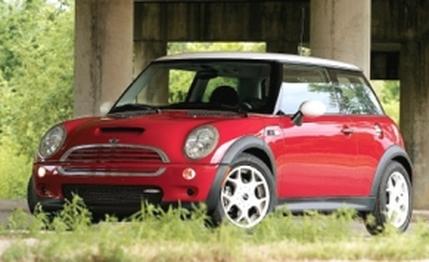 Short Take Road Test
Short Take Road Test
Sales of the Mini Cooper are booming—more than 20,000 have been sold here through July 2003. And half of those have been the more-spirited Cooper S. The Mini's cool retro styling, small size, and agile handling, and the Cooper S's 163-hp engine, make the car a feast for the senses. But to make the Mini as sporty as some of its comparably priced competitors, such as the Acura RSX, it needs some extra zip, and that's what the John Cooper Works package delivers.
History has a way of repeating itself. In 1961, English race-car manufacturer John Cooper took the original Mini, a small, efficient car designed by Sir Alec Issigonis, and turned it into a very entertaining vehicle by upping the little car's horsepower from 33 to a much more lively 55. John Cooper hoped he would sell 1000 cars. He ended up selling 25,000.
Now it is Cooper's son, Mike, and his company, John Cooper Works of East Preston in Sussex, England, that are pumping up the reborn Mini—in this case, the livelier Mini Cooper S. This is strictly an engine kit—no changes are aimed at the suspension, chassis, or brakes. The world is notified of these improvements via a few discreet chrome JCW logos on the sides and front and rear of the car and stampings on the dual chrome exhaust tips.
Under the hood, the intercooler has a silver surround with the JCW logo on it and an individually numbered plaque for each kit. Hidden out of view is the real go-fast hardware. There is a more efficient Eaton supercharger whose vanes are specially coated with a ceramic compound to provide better sealing. Additionally, a smaller drive pulley increases the boost from 11.6 to 14.5 psi. The cylinder head is ported and polished for better flow and to reduce hot spots that might lead to long-term damage. The stock camshaft and compression ratio are retained. A new dual-exhaust system reduces back pressure and increases flow, and the engine-control computer is reprogrammed for increased air and fuel flow.
All these upgrades produce a healthy 23-percent increase in horsepower, boosting the 163 horsepower and 155 pound-feet of torque of the 1.6-liter SOHC 16-valve four-cylinder engine of the Cooper S to 200 horsepower and 177 pound-feet of torque in the JCW version.
That translates into much quicker acceleration times. The last Cooper S we tested (July 2002) took seven seconds to reach 60 mph. The JCW package drops that time to 6.4 seconds. Our stock Cooper S ran the quarter-mile in 15.5 seconds at 90 mph. The JCW car turned the quarter in 14.7 seconds at 95 mph. Top-gear acceleration also increased radically. The JCW Mini went from 50 to 70 mph in sixth gear in 8.9 seconds, which is 3.4 seconds quicker than the Cooper S. Such improved midrange response makes this pumped-up S a much more aggressive highway cruiser that's better able to take advantage of holes in traffic. On the other hand, our test car didn't corner or stop as well because of its standard-equipment skinny 16-inch tires. The Cooper S we tested in July 2002 had 17-inchers, and it cornered better and squealed its tires less under full-throttle acceleration. JCW offers a set of unique 18-inch wheels and tires.
As usual, there's still no free lunch. All these performance enhancements come with a $5000 price tag. The parts are $4500, and the nine hours of labor for installation at your local Mini dealer add on another $500. The JCW package can be retrofitted to S models only, and the balance of the Mini's factory warranty will still be valid. Our test car was a stripped-down Mini Cooper S with no options other than the JCW package, bringing the final tab to $24,975. Adding a sunroof, bigger tires, leather seats, and other options would have upped the tab over $28,000. That's a couple grand more than a similarly equipped, sportier-looking, and just as quick Acura RSX Type-S.
The JCW package may not be cheap, but its added performance makes an already fun car even more entertaining.